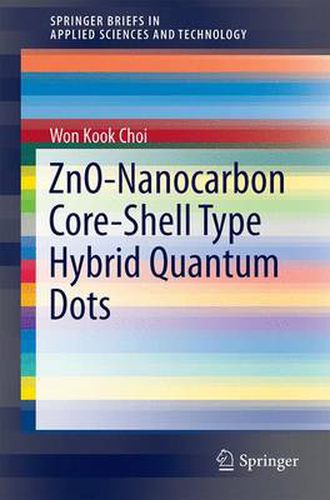Readings Newsletter
Become a Readings Member to make your shopping experience even easier.
Sign in or sign up for free!
You’re not far away from qualifying for FREE standard shipping within Australia
You’ve qualified for FREE standard shipping within Australia
The cart is loading…






This book offers a comprehensive overview of ZnO-nano carbon core shell hybrid issues. There is significant interest in metal oxide/nanocarbon hybrid functional materials in the field of energy conversion and storage as electrode materials for supercapacitors, Li ion secondary battery, electrocatalysts for water splitting, and optoelectronic devices such as light emitting diodes and solar photovoltaic cells. Despite efforts to manipulate more uniform metal oxide-nanocarbon nanocomposite structures, they have shown poor performance because they are randomly scattered and non-uniformly attached to the nanocarbon surface. For higher and more effective performance of the hybrid structure, 3D conformal coating on metal oxides are highly desirable.
In the first part of the book, the physical and chemical properties of ZnO and nanocarbons and the state-of-the-art in related research are briefly summarized. In the next part, the 3D conformal coating synthetic processes of ZnO templated nanocarbon hybrid materials such as ZnO-graphene,-C60, single-walled (SWCNT) are introduced with the aid of schematic illustrations. Analysis of their chemical bonding and structure are also presented. In the final section, several applications are presented: UV photovoltaic cells and photoelectrochemical anodes for water splitting using ZnO-C60 and ZnO-graphene, white-light-emitting diodes based on ZnO-graphene quantum dots(GQDs), inverted solar cells using ligand-modified ZnO-graphene QDs, and P(VDF-TrFE) copolymer with mixed with nano-ring SWCNT.
The book describes how strong anchoring bonds between a ZnO core and carbon nanomaterial shell will ultimately prevail over the main drawbacks of ZnO with high charge recombination and poor electrochemical stability in liquid solutions. Due to the moderate energy states and excellent electric properties of the nanocarbons, ultrafast charge carrier transport from the ZnO core to the nanocarbon shell is guaranteed with the use of the photoluminescence (PL) lifetime measurement.
Given the growing interest and significance of future research in optoelectronic and electrochemical devices applications, the contents are very timely. This book is targeted towards researchers looking for highly efficient metal oxide-nanocarbon hybrid functional materials in the fields of nano-optoelectronics, photoelectrochemistry, energy storage and conversion.
$9.00 standard shipping within Australia
FREE standard shipping within Australia for orders over $100.00
Express & International shipping calculated at checkout
This book offers a comprehensive overview of ZnO-nano carbon core shell hybrid issues. There is significant interest in metal oxide/nanocarbon hybrid functional materials in the field of energy conversion and storage as electrode materials for supercapacitors, Li ion secondary battery, electrocatalysts for water splitting, and optoelectronic devices such as light emitting diodes and solar photovoltaic cells. Despite efforts to manipulate more uniform metal oxide-nanocarbon nanocomposite structures, they have shown poor performance because they are randomly scattered and non-uniformly attached to the nanocarbon surface. For higher and more effective performance of the hybrid structure, 3D conformal coating on metal oxides are highly desirable.
In the first part of the book, the physical and chemical properties of ZnO and nanocarbons and the state-of-the-art in related research are briefly summarized. In the next part, the 3D conformal coating synthetic processes of ZnO templated nanocarbon hybrid materials such as ZnO-graphene,-C60, single-walled (SWCNT) are introduced with the aid of schematic illustrations. Analysis of their chemical bonding and structure are also presented. In the final section, several applications are presented: UV photovoltaic cells and photoelectrochemical anodes for water splitting using ZnO-C60 and ZnO-graphene, white-light-emitting diodes based on ZnO-graphene quantum dots(GQDs), inverted solar cells using ligand-modified ZnO-graphene QDs, and P(VDF-TrFE) copolymer with mixed with nano-ring SWCNT.
The book describes how strong anchoring bonds between a ZnO core and carbon nanomaterial shell will ultimately prevail over the main drawbacks of ZnO with high charge recombination and poor electrochemical stability in liquid solutions. Due to the moderate energy states and excellent electric properties of the nanocarbons, ultrafast charge carrier transport from the ZnO core to the nanocarbon shell is guaranteed with the use of the photoluminescence (PL) lifetime measurement.
Given the growing interest and significance of future research in optoelectronic and electrochemical devices applications, the contents are very timely. This book is targeted towards researchers looking for highly efficient metal oxide-nanocarbon hybrid functional materials in the fields of nano-optoelectronics, photoelectrochemistry, energy storage and conversion.